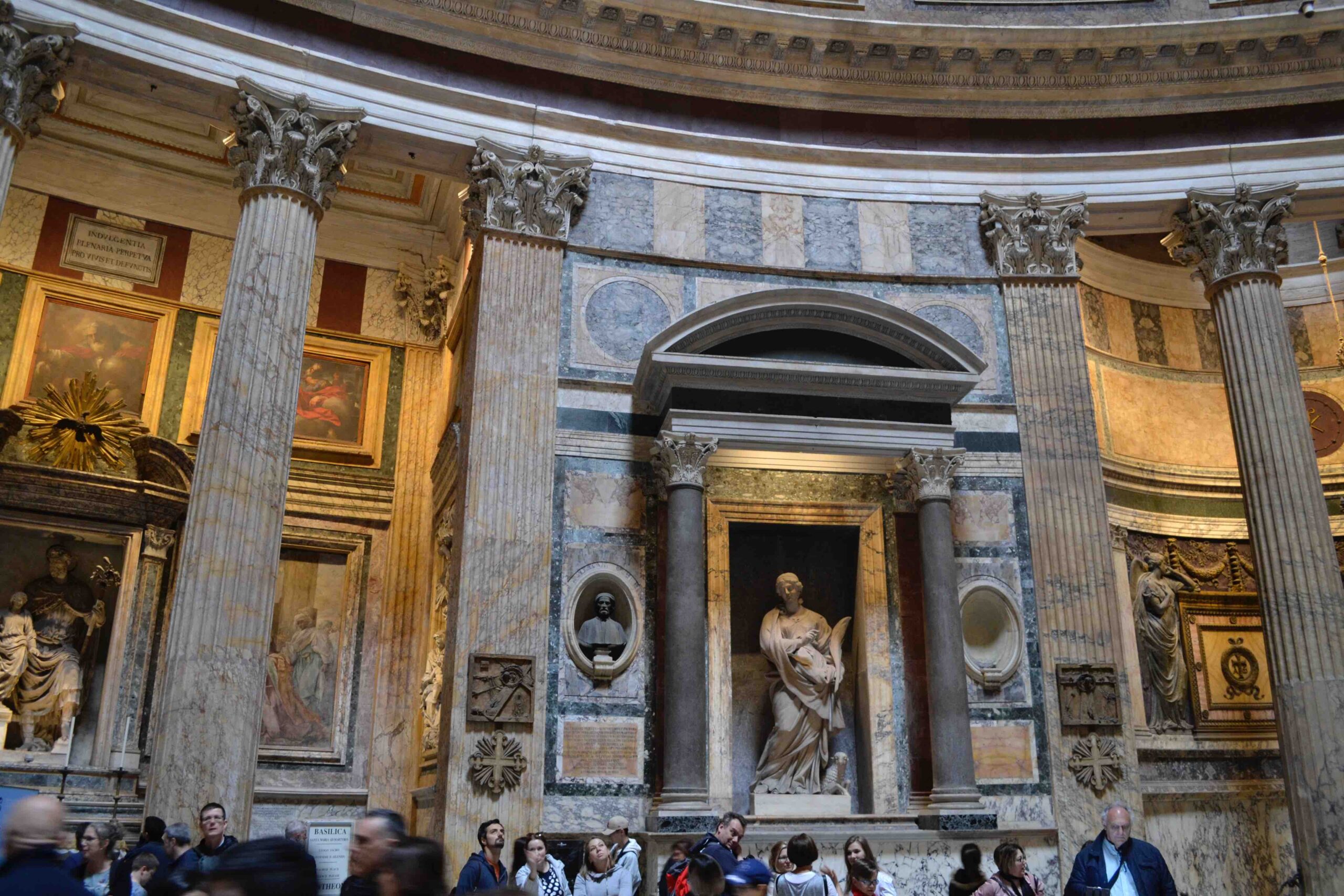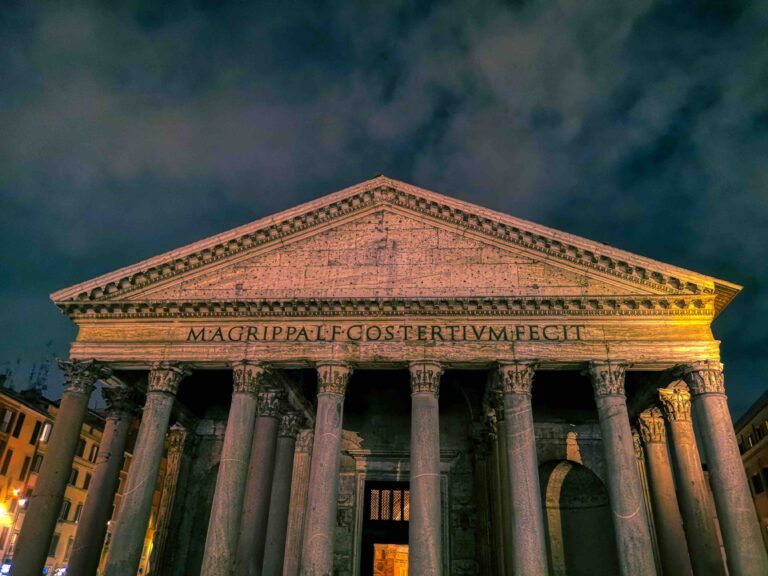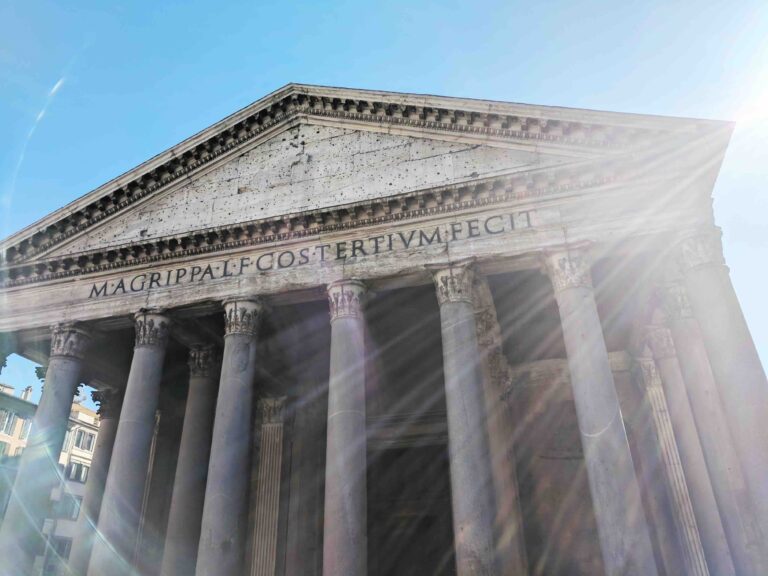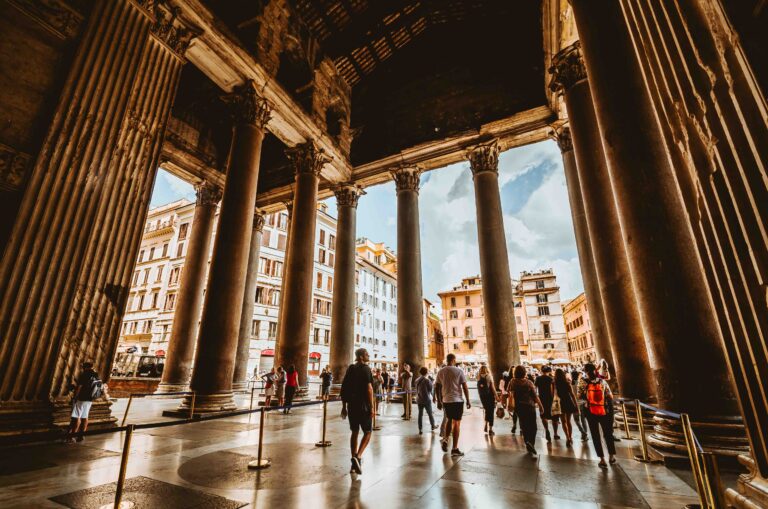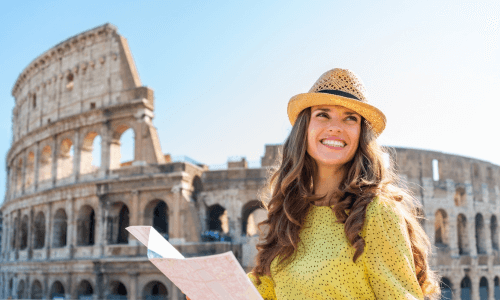You walk into the Pantheon expecting to admire the massive dome and that perfect circle of light shining through the oculus. But then you notice something unexpected. Tucked quietly along the curved walls are marble tombs. Some hold kings. One belongs to a Renaissance genius loved by millions. Suddenly, this is no longer just an architectural wonder. It is a resting place.
Most visitors never realize that Pantheon Rome burials are a major part of its story. Yes, people are actually buried here. Real bodies. Real history. Royalty and artists who shaped the identity of Italy.
It is rare to find a building that has survived two thousand years and still carries so many roles. It began as a pagan temple. Then it became a Christian church. Today, it is also a mausoleum where great figures are honored for eternity.
If you have ever wondered who is buried in the Pantheon, why they were chosen, or how to find their tombs when visiting, this guide will take you through every detail, in a simple and respectful way.
Is the Pantheon in Rome Really a Burial Site?
The answer is yes, but it was not always meant to be.
When Emperor Hadrian rebuilt the Pantheon in the second century, it was dedicated to all the Roman gods. There were no tombs here. Ancient Romans cremated their dead, so burials inside temples were not common.
Everything changed in the year 609. The Byzantine emperor gifted the Pantheon to the Pope, and it was converted into a Christian church. Its new name became Santa Maria ad Martyres. From that moment, it became a sacred place of worship, and churches naturally welcome burials.
Still, not just anyone could be laid to rest here. The people chosen later were not placed here by accident. Each burial was symbolic. Each one was a public message. The Pantheon was not just a church. It had become a national shrine.
Today, it is both a tourist attraction and a functioning religious space, which makes visiting it even more meaningful. You are not only stepping into history. You are stepping into a place where people are remembered.
Who Is Buried in the Pantheon? A Complete List of Tombs
If you walk around the circular interior, you will find several marked tombs built into the walls. Some are simple. Some are grand with sculptures and crests. Each one holds a story.
Here are the main people buried in the Pantheon:
| Name | Title or Role | Year of Death | Location Inside the Pantheon |
|---|---|---|---|
| King Vittorio Emanuele II | First King of Unified Italy | 1878 | Left side chapel |
| King Umberto I | Second King of Italy | 1900 | Right side, near his wife |
| Queen Margherita of Savoy | First Queen of Italy | 1926 | Beside King Umberto I |
| Raphael Sanzio | Renaissance Painter | 1520 | Left of the main altar |
| Annibale Carracci | Baroque Painter | 1609 | Chapel of the Crucifix |
Some sources also mention architects and church figures connected to the Pantheon, but Raphael and the Italian kings are the most famous names people come looking for.
Each burial reflects a different chapter in Italian history. Raphael represents artistic genius. Vittorio Emanuele II represents national unity. Umberto I and Queen Margherita reflect royal legacy and devotion.
When you stand before their tombs, you begin to see the Pantheon not only as a building, but as a timeline carved in stone.
Why Were These Figures Chosen for Pantheon Rome Burials?
Not everyone could earn a place in the Pantheon. Being buried here meant one thing, you were part of Italy’s soul.
When the Renaissance painter Raphael died in 1520, he was already beloved across Europe. His art was graceful, balanced, and deeply spiritual. He personally requested to be buried in the Pantheon. It was an unusual choice at the time because most artists were buried in lesser-known churches. But Raphael saw the Pantheon as the symbol of perfect beauty, a link between the ancient world and the Christian world. His friends honored his wish, and his funeral drew crowds of mourners.
Centuries later, when Italy finally became a unified country in the 1800s, people needed symbols of national pride. The government declared the Pantheon a “Temple of the Fatherland.” They chose it as the final resting place for King Vittorio Emanuele II, the man credited with uniting Italy into one nation. His burial turned the Pantheon into a patriotic shrine.
After him, King Umberto I and Queen Margherita of Savoy were buried there as well, completing the royal line inside this sacred space. Their presence makes the Pantheon not just a church and not just a work of architecture, but a living reminder of Italy’s unity, faith, and creative spirit.
Raphael’s Tomb: The Heart of the Pantheon
Among all the burials inside the Pantheon, Raphael’s tomb is the one that visitors seek most. It sits quietly to the left of the main altar, marked by a smooth marble arch.
His tomb is beautifully simple. Above it stands a statue of the Virgin Mary, sculpted by one of his students. Below it lies a Latin inscription that translates to:
“Here lies Raphael. While he lived, nature feared he would surpass her. When he died, she feared she would die with him.”
It is poetic. It is emotional. And it fits his legacy.
People still leave fresh flowers on his tomb today. Art students sketch nearby. Some visitors sit in silence just to take in the weight of his presence. There is something moving about standing a few feet away from one of history’s greatest painters.
If you plan to visit, walk slowly along the left side after entering. You will know you’ve found it when you see the soft glow of candles and a bronze shield carved with Raphael’s name.
The Royal Tombs of Vittorio Emanuele II and Umberto I
On the opposite side of Raphael rests a different kind of power, not artistic but political.
King Vittorio Emanuele II — The Father of the Nation
His tomb is located in the left aisle chapel. It is large, dark, and guarded by a bronze eagle and shields. You will often see a small honor guard standing nearby, as Italian soldiers still pay tribute to him.
He was not just a king. He was a symbol of unity. Before him, Italy was divided into small regions ruled by foreign powers. Under his rule, it became one country. That is why his tomb simply carries the engraving: “Father of the Nation.” No dates. No titles. Just legacy.
King Umberto I and Queen Margherita — A Royal Couple United in Death
Across from Vittorio Emanuele lies his son, King Umberto I, buried alongside his wife Queen Margherita. Their joint resting place feels softer, with floral decorations and gentler lighting. Queen Margherita was deeply loved by the people. She was also the inspiration behind Pizza Margherita, which was named after her when she visited Naples.
Even in death, the royal couple represent tradition and loyalty. Their tomb is not as grand as Vittorio Emanuele’s, but it carries a quiet dignity.
Can You Attend Mass or Ceremonies at the Pantheon?
Yes, you can. The Pantheon is still an active church, officially named Basilica of Santa Maria ad Martyres. That means it is not only a monument, it is a place of worship.
If you happen to visit in the early morning, you may hear soft organ music playing as the first Mass of the day begins. Locals still come to pray, and priests walk through quietly preparing for service. On most weekdays, Mass is held around 5:00 PM, while on Sundays and religious holidays, it usually takes place in the late morning.
Special ceremonies are also held each year to honor the people buried here. On June 2nd, Italy’s Republic Day, officials gather in front of King Vittorio Emanuele II’s tomb to lay a wreath. Military officers salute in full uniform, and the space fills with a feeling of national pride. On April 6th, admirers leave flowers for Raphael on the anniversary of his death.
If you attend one of these services, dress modestly, stay quiet, and avoid walking around during prayer. You are not just visiting a tourist site, you are entering someone’s resting place.
How to Visit the Tombs Respectfully
Walking into the Pantheon is a powerful moment, but it deserves quiet respect. Here are some gentle tips for visiting the burial areas with care:
- Move slowly around the interior and take time to notice each tomb instead of rushing through.
- Speak softly — echoes travel easily under the dome.
- Avoid tapping or leaning on tombs for photographs. Many visitors do this without thinking, but it is best to admire from a small distance.
- Photography is allowed, but avoid using flash directly on memorials or pointing cameras during prayers or Mass.
- If you see candles or flowers near a tomb, do not touch or move them. They are often left by families or admirers.
You are free to admire and reflect. The Pantheon invites curiosity, as long as it is paired with respect.
Are There Still Burials Taking Place in the Pantheon?
Officially, no new burials have been added in recent decades, but the topic still sparks discussion among Italians.
Some argue that the Pantheon should remain closed to further burials, preserving it exactly as it is, a perfect blend of art, royalty, and faith. Others believe that future national heroes could also earn a place here. There have even been suggestions to bury modern-day figures like poets or presidents, but so far, none have been accepted.
For now, Raphael and the royal family remain the last to join the Pantheon burials.
Still, the idea lingers in the air. When you stand beneath the dome and look at the tombs, you cannot help but wonder, if another great Italian were to be honored, would they rest here too?
Myths and Legends Surrounding Pantheon Burials
A building as old as the Pantheon naturally collects stories, some true, some whispered, and some simply born from imagination.
One of the most repeated legends says that Raphael’s tomb is watched over by his spirit. Some late-night visitors claim to have felt a chill or soft footsteps behind them while standing near his resting place. Others say they have seen a faint shadow seated quietly by the candles. Whether you believe in ghosts or not, the silence around his tomb carries a certain weight , as if the building itself remembers him.
Another legend comes from the giant oculus above. Rain falls straight through the open roof, yet the floor never seems to stay wet. In ancient times, people believed the gods protected the Pantheon and kept rain from touching sacred ground. In truth, the floor is slightly curved with tiny drainage holes, but the illusion remains magical, especially when raindrops fall near the royal tombs.
Some even believe that other important Italians may be secretly buried beneath the floor, though no proof has ever been found. It is likely just a romantic story, but in a place like this, mystery feels fitting.
Quick FAQ About Pantheon Rome Burials
Is Raphael really buried in the Pantheon?
Yes. Raphael’s tomb is on the left side of the interior, and it is one of the most visited spots inside the building.
How many kings are buried in the Pantheon?
Two Italian kings, Vittorio Emanuele II and Umberto I, along with Queen Margherita of Savoy.
Is the Pantheon still used for burials today?
No. The most recent burials were in the early 1900s. There are no current plans for more.
Can I visit the tombs for free?
Entry rules change over time. The Pantheon is free on some days, but now often requires a small ticket fee. Once inside, all tombs can be viewed without extra cost.
Is it okay to take pictures of the tombs?
Yes, but avoid flash and be respectful, especially during Mass or ceremonies.
Final Thought: A Place Where Time Stands Still
The Pantheon is one of those places that refuses to stay in a single category. It is not just a church. Not just a monument. Not just a masterpiece. It is a resting place where history breathes through silence.
When you stand beneath the open sky of the oculus and look toward the tombs, of painters who shaped how we see beauty and kings who shaped how a country stands united, you feel something rare. You feel connected to people who lived long before you, yet left behind something that still matters.
Most landmarks impress you with size. The Pantheon does more. It humbles you.
If you ever visit, pause a moment beside one of the burials. Read a name. Whisper a thank you if you feel moved to. Because here, among stone and shadow, history is not just remembered, it is honored with every quiet step you take.

